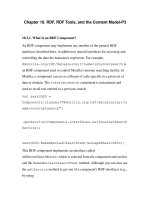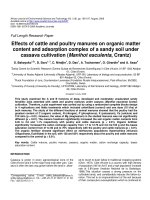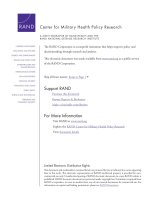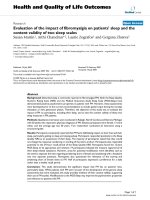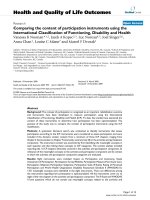Housing market challenges in Europe and the United States
Bạn đang xem bản rút gọn của tài liệu. Xem và tải ngay bản đầy đủ của tài liệu tại đây (1.12 MB, 284 trang )
Housing Market Challenges in Europe and the United States
This page intentionally left blank
Housing Market Challenges
in Europe and the
United States
Any Solutions Available?
Edited by
Philip Arestis
Peter Mooslechner
and
Karin Wagner
Editorial and selection matter © Philip Arestis, Peter Mooslechner
and Karin Wagner 2009
Individual chapters © Contributors 2009
All rights reserved. No reproduction, copy or transmission of this
publication may be made without written permission.
No portion of this publication may be reproduced, copied or transmitted
save with written permission or in accordance with the provisions of the
Copyright, Designs and Patents Act 1988, or under the terms of any licence
permitting limited copying issued by the Copyright Licensing Agency,
Saffron House, 6–10 Kirby Street, London EC1N 8TS.
Any person who does any unauthorized act in relation to this publication
may be liable to criminal prosecution and civil claims for damages.
The authors have asserted their rights to be identified as the authors of this
work in accordance with the Copyright, Designs and Patents Act 1988.
First published 2009 by
PALGRAVE MACMILLAN
Palgrave Macmillan in the UK is an imprint of Macmillan Publishers Limited,
registered in England, company number 785998, of Houndmills,
Basingstoke, Hampshire RG21 6XS.
Palgrave Macmillan in the US is a division of St Martin’s Press LLC,
175 Fifth Avenue, New York, NY 10010.
Palgrave Macmillan is the global academic imprint of the above companies
and has companies and representatives throughout the world.
Palgrave® and Macmillan® are registered trademarks in the United States,
the United Kingdom, Europe and other countries.
ISBN 978–0–230–22903–7 hardback
This book is printed on paper suitable for recycling and made from fully
managed and sustained forest sources. Logging, pulping and manufacturing
processes are expected to conform to the environmental regulations of the
country of origin.
A catalogue record for this book is available from the British Library.
A catalog record for this book is available from the Library of Congress.
10 9 8 7 6 5 4 3 2 1
18 17 16 15 14 13 12 11 10 09
Printed and bound in Great Britain by
CPI Antony Rowe, Chippenham and Eastbourne
Contents
List of Figures
vii
List of Tables
ix
Notes on the Contributors
xi
1 Introduction: Housing Market Challenges in Europe and
the United States
Philip Arestis, Peter Mooslechner and Karin Wagner
2 Housing Markets in Europe and in the USA: What Are
the Relevant Issues Today?
Peter Mooslechner and Karin Wagner
3 Subprime Mortgage Market and Current Financial Crisis
Philip Arestis and Elias Karakitsos
4 Determinants of Homeownership Rates: Housing Finance
and the Role of the State
Elisabeth Springler and Karin Wagner
5 The Rental Housing Market
Dieter Gstach
Housing Markets, Business Cycles and Economic Policies
Christophe André and Nathalie Girouard
7
European Rental Markets: Regulation or Liberalization?
The Spanish Case
Montserrat Pareja-Eastaway and María Teresa Sánchez-Martínez
Fiscal Aspects of Housing in Europe
Guido Wolswijk
9 Towards a New Housing System in Transitional Countries:
The Case of Hungary
József Hegedüs
10
15
40
60
85
6
8
1
House Price and Other Housing Market Data: A User’s
Perspective
Anthony Murphy
v
109
131
158
178
203
vi
Contents
11 Residential Property Price Statistics for the Euro Area
and the European Union
Martin Eiglsperger
221
12 Housing and Financial Wealth in Austria:
What Can Survey Data Tell Us for the Analysis of
Financial Stability Issues?
Pirmin Fessler, Peter Mooslechner, Martin Schürz and
Karin Wagner
239
Index
264
List of Figures
2.1
2.2
2.3
4.1
4.2
4.3
5.1a
5.1b
5.2a
5.2b
5.3a
5.3b
5.4
5.5
5.6a
5.6b
6.1
6.2
7.1
7.2
7.3
7.4
8.1
9.1
9.2
9.3
9.4
9.5
9.6
Real housing investment
Mortgage debt outstanding and disposable income
Share of variable rate lending in new loans for house
purchase and mortgage debt to GDP in 2007
Annual changes in homeownership rates in percentage
points, 1997–2006
Selected economies: Supply side allowances to GDP ratio
in per cent in 2001
Development of subsidized housing supply and housing
permissions and completions in Austria, 1996–2003
Yearly growth rates of real rents in per cent
Yearly growth rates of real rents in per cent
Yearly growth rates of real rents in per cent
Yearly growth rates of real rents in per cent
Distribution of disposable household income
Distribution of disposable household income
Rented market shares by household size
Rented market shares by age group
Distribution of rent-to-income ratio in per cent
Distribution of rent-to-income ratio in per cent
OECD real house prices and the business cycle
Marginal propensities to consume out of housing
wealth and mortgage market indicators
Rented housing in several European countries
Contracts and rents in Barcelona, 1984–2007
Regulated and unregulated housing, 1962–2007
‘Disqualified’ regulated housing
Housing taxes, 2006
Macroeconomic trends: GDP, CPI, and interest on
housing (%)
New construction and building permits between 1989
and 2008
House price changes
Housing loans, 1989–2008
Housing subsidies, 1998–2007, as per cent of the GDP
Household borrowing, 1996–2008
vii
21
27
29
63
69
70
93
93
94
94
99
99
101
102
103
103
111
116
134
144
146
147
164
181
183
183
187
188
190
viii
List of Figures
10.1 Channels of transmission of the mortgage and
housing crisis
10.2 Various measures of UK house prices
10.3 Various measures of Greater London house prices
10.4 Estimated long-run effects of changes in the credit
conditions index
10.5 Simulated real US house prices
11.1 Residential property prices for euro area countries,
annual percentage changes
11.2 Residential property prices for non-euro area
EU countries, annual percentage changes
11.3 Residential property prices for the euro area at annual
and semi-annual frequency, annual percentage changes
12.1 Stock and/or mutual fund share holdings by gross
financial wealth decile
12.2 Which sources do you rely on when you seek
information on financial issues?
203
209
209
215
216
224
225
234
252
257
List of tables
2.1 Housing market indicators
2.2 Timing of maximum correlation
4.1 Introduction and usage of securitization
for housing finance in European economies and
the USA
4.2 Fixed effects model for ownership rate
4.3 Fixed effects model for ownership rate
(incl. interest rates)
A4.1 Cost of financing – time series
A4.2 Fixed effects model with instrumental variables
6.1 House prices in real terms and relative to rents
and income
6.2 Short-term and long-term impact of financial and
housing wealth on consumption
6.3 Long-term impact of housing equity withdrawal
on consumption
7.1 Housing tenure
7.2 Tenure in Spain
7.3 Cost of rented dwellings according to the year of
signature
8.1 Main tax categories affecting housing/mortgages in
the euro area, 2007
8.2 Overall housing subsidy measures, 1999
A8.1 Tax on imputed rents
A8.2 Mortgage interest payments tax deductibility
A8.3 Tax on housing capital gains
A8.4 Indirect taxes
9.1 Basic indicators of housing conditions in Hungary,
1970–2000
9.2 Housing allowance, 2000–2007
10.1 Simple mix adjusted house price examples
10.2 Start dates of some European house price data
10.3 Various measures of quarterly ln house prices for
the UK
ix
17
22
67
74
76
79
80
112
115
116
135
144
150
161
165
171
172
173
174
182
196
205
206
210
x
List of Tables
10.4 Data for modeling aggregate house prices
A11.1 Overview table of residential property prices in
EU countries, annual percentage changes
12.1 Ownership rates by socio-economic characteristics
12.2 Logit-regression: determinants of homeownership
217
236
243
248
Notes on the Contributors
Christophe André is an economist in the Economics Department of the
Organisation for Economic Cooperation and Development (OECD). He
has contributed to several editions of the OECD Economic Outlook and has
been involved in macroeconomic modelling and forecasting, as well as
in research in areas ranging from housing to monetary and fiscal policy.
Philip Arestis is University Director of Research, Cambridge Centre for
Economics and Public Policy, Department of Land Economy, University of Cambridge, UK; Distinguished Adjunct Professor of Economics,
Department of Economics, University of Utah, USA; Senior Scholar, Levy
Economics Institute, New York, USA; Visiting Professor, Leeds Business
School, University of Leeds; Department of Finance and Management
Studies, School of Oriental and African Studies (SOAS), University of
London, UK.
Martin Eiglsperger is Senior Economist Statistician in the Euro Area
Accounts and Economic Data Division of the ECB’s Directorate General
Statistics. He held previous positions at the Deutsche Bundesbank, the
German Federal Statistical Office and the Department of Business Administration and Economics of the University of Bamberg. He received a
Ph.D. degree in economics from the University of Bamberg.
Pirmin Fessler is an economist at the Austrian central bank. He studied economics at the University of Vienna. His current research focuses
on wealth inequality, intergenerational transfers and private households’ portfolio choice. He is member of the Household Finance and
Consumption Network of the European Central Bank.
Nathalie Girouard is adviser to the OECD Secretary-General. Before
assuming her responsibilities in the cabinet, Nathalie was part of the
team editing the OECD Economic Outlook. Her fields of research include
consumption behaviour, housing and mortgage markets and their effects
on the wider economy. She has published several working papers and
OECD documents.
xi
xii
Notes on the Contributors
Dieter Gstach is associate professor of economics at Vienna University
of Economics and Business. He is also a member of the Research Institute
for Spatial and Real Estate Economics. His current research focuses on the
macroeconomic role of the housing market.
Jószef Hegedüs is a founding member of the Metropolitan Research Institute, which was established in 1989 in Budapest, Hungary. He has been
co-organizer of the East European Working Group of the European Network for Housing Research since 1989, and a member of the Housing
Policy Council, a high-level advisory group in housing policy matters
in Hungary, since 1996. He has been Affiliated Professor at Corvinus
University since 2007.
Elias Karakitsos is Director of Guildhall Asset Management; chairman
of Global Economic Research; and Associate Member of the Centre for
Economic and Public Policy, University of Cambridge. He was Professor
at Imperial College, Head of Economics for ten years and has acted as an
adviser to governments and financial institutions, including Citibank,
Oppenheimer, Allianz, Credit Agricole and Standard Chartered. He is
the author of five books/monographs, 80 papers in learned journals and
more than 300 reports on financial markets.
Peter Mooslechner is Director of the Economic Analysis and Research
Department of the Oesterreichische Nationalbank, Vienna. He teaches
economics and economic policy at the Vienna University of Economics
and Business Administration and is a member of the Monetary Policy Committee of the ECB. His publications cover macroeconomics,
monetary and fiscal policy, financial markets and Eastern European
issues.
Anthony Murphy is Economics Fellow at Hertford College, University of
Oxford. He is an applied econometrician and works on housing, savings
and labour markets, as well as empirical finance.
Montserrat Pareja-Eastaway is Associate Professor of Economics at the
University of Barcelona, Spain. Housing affordability, tenure and housing policy measures are, among others, key aspects of her research. She
has been the Spanish partner responsible for several EU-funded projects
and is a member of the ENHR Co-ordination Committee.
Notes on the Contributors xiii
María Teresa Sánchez-Martínez is Associate Professor of Economics at
the University of Granada, Spain. Her research interests are housing
finance, distributive aspects of public expenditure on housing and housing policies from a comparative perspective. She has published numerous
articles in specialized journals in the field of housing economy.
Martin Schürz is Head of the Monetary Unit of the Austrian central
bank’s Economic Analysis Division. He teaches at the Vienna University of Economics and Business Administration and at the University of
Applied Sciences (bfi), Vienna. He has published several books and his
research interests are in the field of wealth inequality.
Elisabeth Springler is Assistant Professor at the Vienna University of
Economics and Business Administration, Austria. She has a strong
interest in Post-Keynesian Economics. Her current research interests
are monetary economics, financial structures, regulation of financial
systems and institutions, as well as housing economics.
Karin Wagner works as an economist at the Oesterreichische Nationalbank. Since 1997 she has worked in the Economic Analysis Division of
the Economic Analysis and Research Department. Before this, she did
various research projects. Her research interests include various aspects
of the Austrian economy from a macroeconomic perspective, especially
housing market developments and, from a microeconomic perspective,
wealth survey topics.
Guido Wolswijk is Principal Economist at the European Central Bank,
focusing on fiscal policies in the euro area. Before that, he worked for the
Dutch central bank and at ING Bank. His research interests include fiscal
policy, monetary policy and housing market developments, including
the interaction between these topics.
This page intentionally left blank
1
Introduction: Housing Market
Challenges in Europe and
the United States
Philip Arestis, Peter Mooslechner and Karin Wagner
The Oesterreichische Nationalbank (Central Bank of Austria) in September 2008 organized a conference entitled ‘Housing Market Challenges
in Europe and the United States – Any Solutions Available?’ All the
papers presented at the conference have been substantially revised since
September 2008 to account for more recent developments in the housing markets in both Europe and the United States (USA). The result is
the current book with a slightly different title, comprising 12 chapters.
In what follows in this Introduction we attempt to put the contents of
the book in context and at the same time summarize the contributions.
Peter Mooslechner and Karin Wagner, in Chapter 2, open the discussion with their contribution entitled, ‘Housing Markets in Europe
and in the USA: What are the Relevant Issues Today?’. In a significant
number of recessions, the housing sector has preceded if not caused
the economic downturn – a stylized fact also underlined by the current financial turmoil and economic crisis. The chapter analyzes some
of the key aspects of the economic relevance of housing markets in the
present context. First, it considers the effects that the housing sector and
housing finance have on the macro economy. Since the housing sector accounts for a considerable part of a country’s welfare, wealth and
GDP, it significantly shapes a country’s long-term economic development. In this respect it is important to pin down the underlying drivers
of house prices, and to assess the economic implications of house price
volatility. The differences in house price developments across countries
may reflect country-specific factors like demographic differences, institutional regulations or cyclical positions; but changes in the structure of
housing finance driven by globalization and liberalization are likely to
play an important role as well. Above all, current macroeconomic analysis highlights the role of housing wealth as a household’s principal asset
1
2
Housing Market Challenges in Europe and the United States
and the role of mortgage debt as the largest liability in households’ balance sheets. Besides possible substantial wealth effects on consumption,
changes in house prices can generate significant spillover effects for the
macro economy as a whole, an obvious aspect of the current financial
crisis. Second, fiscal and regulation aspects are important. Specific institutional settings together with the tax treatment of housing expenses
have direct implications for a household’s income and wealth position.
Again, there are fairly strong national differences in the tax deductibility of interest rates, the amount of allowances and subsidies given to
households, and the instruments used for this purpose. Third, housing
finance patterns have a direct effect on housing markets and on households’ wealth position. In this respect, lately there has been a decrease
in the spread between interest rates on loans and the cost of funding,
which may be due to increased competition. In parallel, a tendency to
move away from traditional methods of financing that relied on specialized intermediaries or government programs towards more market-based
systems of housing finance has become visible. At the same time, the
funding of housing loans has changed significantly. In particular, there
has been a boom in securitization, through which house financing has
become international. As a result, fluctuations spill over much more easily from one ‘national’ market to others, indeed to international capital
markets. This is a particular challenge for supervisors because of national
differences in supervisory structures and practices. Finally, the chapter
looks at the relationship between monetary policy and housing markets.
Cross-country differences concerning the structure of mortgage loans
provide for a heterogeneous transmission process. In the USA long-term
fixed-rate mortgages prevail, while other countries mostly use variablerate loans, which lead to a faster transmission of monetary policy shocks.
Despite marked changes in the overall transmission of monetary policy,
the housing market is still one of the main channels of monetary policy.
Philip Arestis and Elias Karakitsos proceed in Chapter 3 to the theme
of ‘Subprime Mortgage Market and Current Financial Crisis’. The thesis of this contribution is that the current financial crisis is the result of
three forces: Financial liberalization, financial innovation (what we now
know as the subprime mortgage market) and easy monetary policy in
the USA, the UK and other countries. The first feature is the financial liberalization policies initiated by governments both in the developed and
developing world since the 1970s. The second feature is an important
financial innovation that emerged following the financial liberalization
experience. The financial innovation in question is based on the issue
of financial structured products, such as Collateralized Debt Obligations
Philip Arestis, Peter Mooslechner, Karin Wagner 3
(CDOs) that played a key role in the swelling of the subprime market.
Other forms of asset backed securities were also issued related to commercial real estate, auto loans and student loans, whereas Credit Default
Swaps (CDSs) were issued to insure investors against the risk of default
of the issuer. The third feature springs from the type of new economic
policies pursued by a significant number of central banks around the
world. This new policy is entirely focused on monetary policy, and the
emphasis on frequent interest rate changes as a means of controlling
inflation. In the USA, Alan Greenspan injected liquidity and cut interest
rates following the Asian–Russian crisis of 1997–98, which was only partially drained later on. Afraid of deflation in the aftermath of the burst
of the internet bubble, Greenspan cut interest rates from 6.5 per cent
to 1 per cent and injected huge liquidity. More important, he was late
and slow in draining that liquidity and reversing the rate cuts from the
middle of 2004. Ben Bernanke imitated Greenspan and injected further
liquidity following the ongoing credit crisis that erupted in the summer
of 2007. This liquidity financed the last and most pronounced phase of
the commodity bubble in the first half of 2008 which pushed the price
of oil to US$ 147 per barrel. The commodity bubble was the last one in
the current cycle, as it affected CPI-inflation. Whereas central banks are
loath in hiking rates to curb asset price inflation, a surge in CPI-inflation
falls squarely into their realm. The surge in commodity prices forced
some central banks, like the ECB, to tighten monetary policy, whereas it
delayed others, like the Fed and the Bank of England, from the urgently
needed rate cuts, thus contributing to the downturn in the autumn of
2008. The acceleration of the economic downturn in the third quarter
of 2008 burst the commodity bubble and demolished the myth of decoupling between developing and developed countries. The impact of
these three types of development has been the creation of enormous
liquidity and household debt in the major economies but which, in
the USA and UK in particular, has reached unsustainable magnitudes
and produced the current crisis. This contribution relies on these three
features for an explanation of the origins of the current crisis. But ultimately the focus of this contribution is on the creation and subsequent
developments in the subprime mortgage market.
Elisabeth Springler and Karin Wagner turn their attention in Chapter 4
to homeownership in an attempt to examine the ‘Determinants of
Homeownership Rates: Housing Finance and the Role of the State’. They
argue that the current financial and real economic crises started off in the
USA when the housing bubble burst and led to a global economic recession affecting both industrialized and emerging markets. Given similar
4
Housing Market Challenges in Europe and the United States
developments in the housing markets in numerous European economies
compared to the pre-housing-crises experience observed in the USA, the
fear has arisen recently that a similar experience is inevitable in Europe.
A number of contributions have avoided analyzing the impact of institutions and the role of the state in implementing economic policies to
promote the housing sector. Additionally, studies of housing bubbles,
with only a few exceptions, neglect completely the impact of homeownership rates. Although – and similar to the development of house
prices – homeownership rates also increased in most economies recently.
Combining these two missing elements in current economic research,
this chapter focuses on the determination of homeownership rates in
the European economies and in the USA. Special attention is paid to
the role of the state in providing tax exemptions and other indirect
subsidies. These incentives of the state can additionally be promoted
by measures in the financial sector. In this context, especially the liberalization of mortgage markets that led to a decrease in interest rates
can be seen as a further incentive for the promotion of homeownership
rates. The underlying hypotheses for the determination of homeownership rates in the light of the current crises are the following: First of all,
tax incentives have a positive impact on homeownership rates. Second,
interest rates have an inverse impact on homeownership rates, which
lead to the conclusion that the current liberalization of European mortgage markets and the ongoing innovations in the field of housing finance
have a positive impact on homeownership rates. If these interrelations
can be detected, further light can be shed on the explanation of the
housing crises, by connecting this evidence with the existing literature
on house bubbles. As interest rates serve as an important explanatory
variable of house price developments, they also turn out to be a crucial factor of housing bubbles; consequently, a clear causal interrelation
between economic policies of the state and house prices can be detected.
Economic policies become a direct factor for homeownership rates and
gain indirectly increasing importance in the determination of housing
bubbles. Taking the observed negative effects of the housing crises in
the USA for individual households into account, the need to rethink
economic policy emerges. Not only do housing crises not seem to be
determined by market forces, they are directly fostered by the policies
of the public sector owing to the increase in homeownership rates. To
empirically test for the described interrelations between homeownership
rates, the role of the state and housing finance products, a time series
model of mortgage debt and cost of financing an owner-occupied home
is applied to European economies and to the United States.
Philip Arestis, Peter Mooslechner, Karin Wagner 5
Dieter Gstach in Chapter 5, ‘The Rental Housing Market’, analyzes
the current and potential role of rental housing in the macroeconomic
housing literature. Recent data on rental housing are contrasted with
the handling of rental housing in the literature. Particularly, results from
2006 micro data are used to provide relevant statistics regarding the role
of rental housing. It is argued that the neglect of rental markets is a
serious gap in macroeconomic analysis involving housing markets. In
housing studies rental housing has always been an important topic. But,
when it comes to the economic role of housing within more general
setups, matters are very different. In this more scattered literature the
rental housing sector is largely neglected. This observation even applies
to special journal issues dedicated especially to the macroeconomics of
housing, such as volume 13/4 of the Journal of Housing Economics or
volume 24/1 of the Oxford Review of Economic Policy. This leads to the
question of whether it is indeed justified to proceed with as-if-economics
and simply assume the rental market away. Two variations of this question emerge: Can we really ignore the possibility that rising house prices
via rising rents exert a negative long-run impact upon consumption?
Is the widespread institution of rent indexing, which directly affects
the consumer price index, really irrelevant for price stability? As, for
example, the above-mentioned micro data suggest, renting households
on average have significantly lower disposable incomes than owneroccupiers. The ratio is roughly 3:2 between owner incomes and incomes
from renting with rising tendency. Data also show that households that
rent typically spend 25 per cent of disposable income on rent with rising
tendency again. These figures together with average shares from renting
of 30 per cent in industrialized countries, amount to almost 6 per cent
of aggregate consumption taking the form of rental payments (for equal
average consumption propensities). Consequently, 6 per cent would also
be the weight of rents in national price indexes (typically they are higher,
for various reasons). So, the story about the housing market and the
macro economy should be augmented by considerations of a rent channel. While it may take some time for this channel to become effective,
it points in the opposite direction of the collateral effect. A major reason behind this effect could be different consumption propensities of
tenants and landlords, which should come as no surprise given the significantly different incomes of homeowners and renters. Furthermore, as
various policy measures influence rents directly, the latter may also play
a macroeconomic role in the short run. Such measures include not only
the most obvious case of direct rent and tenancy regulations, but many
more, such as tax treatment of rental income, subsidization of ‘second
6
Housing Market Challenges in Europe and the United States
homes’ and, more generally, the various measures affecting the relative
price between rental and owner-occupied housing. Many deficiencies of
housing related statistics are well documented in the literature and have
been pointed out in various contributions to this book. This is not true
for the notorious lack of reliable and internationally comparable rental
rate data. But these are required to test whether indeed rental housing is
irrelevant for macroeconomic analysis as the relevant strand of literature
on housing implies.
Christophe André and Nathalie Girouard in Chapter 6, entitled ‘Housing Markets, Business Cycles and Economic Policies’, argue that from the
mid-1990s to 2006–07, the vast majority of OECD countries experienced
an exceptional expansion of their housing markets, both in terms of
magnitude and duration. Moreover, deviating from historical patterns,
the latest housing upswing has been disconnected from the business
cycle, as the economic downturn of the early years of the century was
not accompanied by a slowdown of housing markets. Housing has contributed to the expansion of economic activity by enhancing the effect
of interest rate cuts on economic growth: Residential investment has
been strong and wealth effects have supported private consumption,
especially in English-speaking countries. Estimates of long-run marginal
propensities to consume out of housing wealth are in the range of 0.05
and 0.08 in Australia, Canada, the Netherlands, the United Kingdom
and the United States, while they are much lower in other continental European countries and Japan. Econometric investigations point to a
transmission of housing wealth to private consumption through the refinancing of mortgages and home equity loans (more generally housing
equity withdrawal). This extraction of liquidity from the housing market
has been strongest in countries with the most innovative mortgage markets, which offered a wide range of products and allowed broad access
to financing; for example through high loan-to-value ratios, second
mortgages, equity release products, alternative interest rate adjustment
and repayment structures or subprime loans. Financial innovations have
contributed to excessive lending and housing booms, which are at the
root of the current financial turmoil. Tax systems favoring home ownership through tax deductibility have sometimes exacerbated the problem.
These developments have revived the debate on the role of monetary
policy in asset price cycles and on the optimal features of regulation and
supervision of financial markets and institutions. For monetary policy to
be efficient in containing asset price bubbles, it is generally considered
that three conditions need to be met: First, monetary authorities need
to detect the development of a bubble in a timely manner; second, a
Philip Arestis, Peter Mooslechner, Karin Wagner 7
modest tightening of monetary policy needs to be able to control speculation; and third, expected gains from avoiding a bubble in terms of
medium-term macroeconomic performance must be substantial. Obviously, the severity of the current recession requires preventive action.
However, the difficulty in meeting the first two conditions implies that
monetary policy is probably too blunt a tool to deal with asset bubbles,
even if ‘leaning against the wind’ strategies are sometimes applied. While
loose monetary policy has fuelled the housing boom, many excesses in
credit expansion would have been prevented by adequate regulation and
supervision. In particular, a dramatic growth in the share of assets held
outside the traditional banking system, especially in investment banks,
structured investment vehicles, conduits and hedge funds, has weakened the control over the financial system. Restoring conditions for a
sustainable development of housing markets will imply reinforcing the
supervision and regulation of the financial system, in particular controlling the level of leverage, avoiding pro-cyclical provisioning and capital
standards. Improving risk management and transparency and ensuring
appropriate underwriting standards are further requirements.
Montserrat Pareja-Eastaway and María Teresa Sánchez-Martínez focus
on the rented markets in Chapter 7, ‘European Rental Markets: Regulation or Liberalization? The Spanish Case’. They argue that housing
markets show nowadays a peculiar transformation in Europe and the
United States. Not only do they reflect the current economic scenario
but also they portray the results of recurrent housing policies over time.
The European landscape provides quite a diverse picture in terms of the
dominance of one form of tenure from another. Academic literature has
described the evolution of European housing systems by means of comparative analysis and the selection of representative case studies. In the
majority of European countries, a massive construction of social housing,
mainly publicly rented, took place after the Second World War in order to
provide shelter for low-income earners. However, the tenure pattern has
been developed and transformed by each country according to its own
socio-political system, especially so in terms of the interaction of the
demand and supply forces and housing policy priorities. Nowadays, the
change of the economic scenario directly affects the approach adopted
towards the mechanisms used by housing policies in order to achieve
their targets. Housing markets are currently unstable and uncertainty
characterizes any expectation on the final market outcome. However,
in terms of tenure, there are some general trends at the European scale,
that is to say, a general increase in homeownership and a fall in size and
quality of the rented dwellings. The characteristics of the rented markets
8
Housing Market Challenges in Europe and the United States
and their regulations vary across Europe. In some cases, the percentage
of dwellings oriented to this segment has been stable (e.g. Germany);
in others, it has fallen dramatically (e.g. Spain). In many cases, rent
controls or certain regulations are implemented. Different reasons lie
behind the need to regulate or control the market; the question is the
extent to which the evolution of the rented markets in terms of rent and
size depends upon the attributes of their regulation. In other words, are
there any other variables to take into account to analyze and forecast
the relative importance of rented markets in Europe? In particular, how
do the economic scenario and the specific measures of housing policy
affect the rented sector development? The aim of Chapter 7 is two-fold:
First, it provides a broad picture of the situation in Europe, covering not
only structural facts of the market but also typologies of regulation; and,
secondly, using this as a framework, it will go in depth on the peculiarities of the Spanish case. Regulations on the rented sector in Spain have
proved to cover a wide spectrum of measures: From the freeze of rents
and duration of contracts to a minimum agreement between landlords
and tenants going through a period of complete liberalization. However,
nowadays the size of the private rented sector scarcely reaches 10 per
cent of the housing stock. Other measures may have certainly influenced
this situation. Finally, the future challenges for policy measures oriented
towards this sector regarding not only the current Spanish situation but
also other European markets, are discussed.
Guido Wolswijk in Chapter 8, ‘Fiscal Aspects of Housing in Europe’,
discusses the role of housing and mortgage markets fiscal instruments.
A large degree of volatility in housing markets and mortgage markets may
have disruptive effects on the economy and also impair financial stability. National governments have various tax and subsidy measures at their
disposal that affect housing decisions. The effectiveness of these instruments has not changed much since the start of EMU as the volume of
cross-border activities in housing remains limited. The chapter focuses
on the euro area countries given the lack of national monetary policy
options for them. This aspect potentially increases the value-added of
national fiscal instruments in affecting housing market developments.
The first part of the chapter describes the set-up of fiscal housing instruments in euro area countries as in the year 2007. It focuses on the
taxation of the imputed rental value of the house, income tax deductibility of mortgage interest payments, capital gains taxes on housing gains,
and VAT rates applying to new houses. While revealing some degree
of diversity, in most countries the fiscal system overall financially favors
owner-occupied housing compared with investment in other assets. This
Philip Arestis, Peter Mooslechner, Karin Wagner 9
preferential treatment is usually motivated by positive external effects
of owner-occupied housing; it is also possible, though, that incomedistribution considerations and effects may also play a role. The chapter
also mentions some possible drawbacks of a non-neutral government
approach to housing markets, including the need to raise taxes on other
activities to finance the preferential treatment of housing. The potential of fiscal instruments for preventing or correcting housing market
imbalances is discussed in the second part of the chapter. Given that
housing markets in the euro area are still predominantly national, fiscal
instruments, unlike the euro area monetary policy, can be geared towards
country-specific developments in housing and housing finance. The
potential roles of such micro policy measures, however, do not always
receive sufficient attention. Structural fiscal measures may contribute
to reducing volatility on housing markets and in this way contribute
to limiting busts that can have disruptive effects on the economy and
on financial stability. Options for governments, for instance, include
increasing the sensitivity of taxes to house prices (for instance, by updating more regularly the market value of houses, which often acts as tax
base of various taxes), and reducing mortgage interest relief which homeowners receive via the tax deductibility of interest payments. Although
there appear to be more arguments in favoring downsizing, the implicit
subsidy given via mortgage interest tax relief and the capitalization of
these benefits in house prices, make introducing or extending limits on
interest deductibility politically difficult. Caution is needed in the use
of fiscal fine-tuning measures, aimed at ad hoc correction of a housing
market imbalance, in normal circumstances. Doubts prevail about possibilities for identifying situations when fiscal authorities should react;
also in terms of the ability to provide adequate time and calibrate such
actions, which may cause a government measure to have pro-cyclical
effects. Precise modalities of fiscal measures, however, need to take into
account the exact situation and the specific national housing market
characteristics.
József Hegedüs, in Chapter 9, ‘Towards a New Housing System in Transitional Countries: The Case of Hungary’, suggests that governments in
the region worked under constant fiscal pressure caused by the social and
economic costs of the bankrupted socialist economy. As a consequence,
the state had to ‘withdraw’ from the housing sector thereby privatizing
the housing sector in its entirety. The chapter uses the case of Hungary
to show the emergence of the new housing model in the region. After
the transitional recession of the 1990s, Hungary launched a new housing
policy in 2000 focusing on three areas of the sector: Development of the
10
Housing Market Challenges in Europe and the United States
mortgage market, renovation of the existing housing stock (especially
urban, multi-unit housing estates) and the rebirth of the social housing
sector. Housing programs went through different stages under the influence of different pressure groups (construction industry, banking sector,
local governments) and political forces (party experts group). The mortgage market was developed by competitive private banks, which were
ready to service emerging middle-class families. The process was supported by a substantial interest rate subsidy, and as a result the share of
outstanding housing loan to GDP increased from 2 per cent to 10 per
cent in four years. Because of the high fiscal cost, the Hungarian government cut the interest rate subsidies in 2004, which, however, did not
stop the growth of the mortgage market. The typically foreign-owned
banks with easy access to the capital market provided low interest rate
foreign currency loans (with high exchange risk and interest rate risk).
From 2004, the share of the foreign currency loans increased from 20 per
cent to 60 per cent, which made the country highly vulnerable to the
economic downturn. The social housing program (construction subsidy
for local governments to build or buy social rental units) was halted in
2004 because of the huge budgetary burden, and it was replaced with a
rent-subsidy program that did not prove to be operational. The rehabilitation of the multi-family, prefabricated housing estates has proved to
be the most successful program since 2004, because it is relatively cheap
and politically effective (reaching a large number of families). Despite
results of the housing programs (increased housing output, growth of
the mortgage market, and increasing renovation in the housing estates),
signs of the housing market crisis emerged, such as a fiscal pressure on
the programs, uneven house price trends, growing inequality in housing conditions, lack of adequate social housing and the regressive subsidy
system. The chapter argues that countries in transition followed the same
trends as they faced the same housing market challenges after the transition, although differences in institutional solutions in housing finance
and housing welfare schemes have become more and more important.
The economic crisis of 2008 has reached the region in a transitional stage
of development of the housing market. The expected economic hardship
caused by the recession will affect the housing market drastically, such
as house price decrease, increasing mortgage arrears, and difficulty to
have access to mortgage. The housing policy response to the crisis will
determine the future housing model in the region.
In Chapter 10, ‘House Price and Other Housing Market Data: A User’s
Perspective’, Anthony Murphy argues that there are data needs for policy makers and others who want to analyze and model housing markets.
